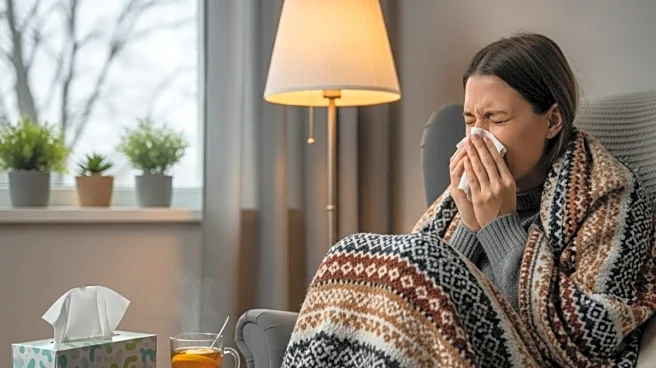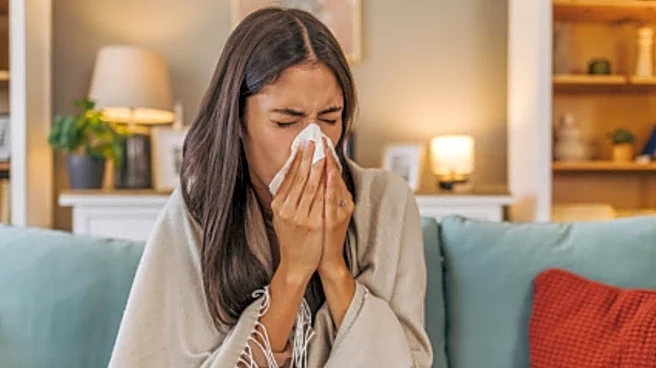Seasonal changes are not just a change of weather or clothes; it exerts measurable and often underestimated effect on human health, particularly on the ears, nose, and throat (ENT). In India, as per the Journal
of the Association of Physicians, respiratory ailments account for approximately 5% to 10% of all primary care consultations, with cough representing nearly 30% of these visits.
Studies indicate that adults experience an average of two acute respiratory episodes per year, while children may encounter up to four, largely during periods of seasonal fluctuation. Chronic conditions, such as persistent cough and phlegm, affect 2.5% and 1.2% of the population, respectively, demonstrating the ongoing vulnerability of ENT systems to environmental stressors.
Winter, in particular, amplifies ENT risks. Low temperatures and dry air dehydrate nasal passages and compromise mucosal immunity, facilitating viral invasions from influenza, respiratory syncytial virus (RSV), and other pathogens. Data from hospital admissions consistently show a marked rise in such infections during colder months, a trend intensified by indoor crowding and communal gatherings.
Research published in the International Journal of Hygiene and Environmental Health and conducted by the Post Graduate Institute of Medical Education and Research (PGIMER), Chandigarh, highlights that variations in temperature, humidity, and airborne allergens significantly increase susceptibility to viral infections and allergic responses.
What Are Seasonal Triggers That Impact ENT Health?
Several environmental factors contribute to ENT issues throughout the year beyond temperature and humidity:
Air quality fluctuations
Pollution, smog, and wildfire smoke introduce irritants and fine particulate matter into the air. Inhaling these pollutants can cause inflammation in the nasal passages, sinuses, and throat, leading to increased allergies, asthma exacerbations, and chronic sinusitis flare-ups. For instance, a recent wildfire in Los Angeles resulted in particulate matter concentrations twenty times higher than the World Health Organization’s safe limit, highlighting the acute impact of air quality on respiratory health.
Temperature swings and immune response
Sudden changes in temperature can affect immune function, making the body more susceptible to infections. Cold air dries nasal passages, reducing their protective function and allowing viruses to enter more easily.
Seasonal viruses
Indoor congregation during colder months facilitates the spread of respiratory viruses, including the common cold, influenza, and respiratory syncytial virus (RSV). Schools, workplaces, and public transport become hotspots for transmission, amplifying the prevalence of ENT-related illnesses.
What Are Common Symptoms of a Cold?
The common cold is caused by hundreds of viruses, including rhinoviruses, adenoviruses, and parainfluenza viruses. Common symptoms include:
- Runny nose
- Nasal congestion
- Cough
- Sneezing
- Sore throat
- Headache
- Mild body aches
- Low-grade fever
Cold symptoms are generally mild compared to more aggressive viruses such as influenza. Most cold viruses resolve naturally within seven to ten days, with the body’s immune system responsible for symptom management. Over-the-counter medications provide only moderate relief, making patience and supportive care essential.
How Does Flu Differ From a Cold?
Seasonal influenza is a highly contagious respiratory infection affecting the nose, throat, and lungs. Symptoms can appear suddenly and include:
- Fever and chills
- Dry cough
- Fatigue
- Body aches
- Runny or stuffy nose
- Sore throat
- Diarrhoea (in children)
Unlike colds, influenza can be prevented with vaccination. Individuals who receive a flu shot generally experience milder symptoms if infected, underscoring the vaccine’s protective value. Most cases resolve without medical intervention, although severe infections may require clinical attention.
How To Spot Symptoms of Seasonal Allergies?
Allergies can be as disruptive in winter as in spring or summer. Triggers include mold spores, dust, and fungal particles. Common symptoms are:
- Runny or congested nose
- Sneezing
- Itchy eyes, nose, or throat
- Watery or red eyes
- Skin rashes
- Wheezing or shortness of breath
- Sinus pressure or headaches
A study published in the International Journal of Hygiene and Environmental Health highlighted that proper knowledge dissemination, allergen avoidance, and timely medication are critical to managing pollen- and mold-related allergies in India.
How Can You Tell If It Is a Cold, Flu, or Allergies?
Beyond infectious risks, seasonal changes also influence immune and metabolic function. Cold exposure activates brown adipose tissue, generating heat while simultaneously altering energy demands and appetite, which may contribute to weight fluctuations. Allergens, including pollen and mold spores, provoke immune responses that can worsen pre-existing ENT conditions such as asthma, chronic sinusitis, and allergic rhinitis. Differentiating between these conditions is crucial for effective management. Some guidelines include:
Signs of infection: Colds and flu are associated with viral infection. Fever and body aches are more pronounced in flu, whereas mild fever can occur with a cold. Allergies rarely cause fever.
Itchiness: Allergies often produce itchy eyes, nose, ears, or throat, which is uncommon in viral infections.
Pattern of symptoms: Seasonal patterns indicate allergies. For example, recurring symptoms every April suggest pollen exposure rather than a random cold.
Duration: Colds typically resolve in one week; allergy symptoms persist as long as exposure continues.
Recent exposure: Close contact with sick individuals points towards viral infection rather than allergy.
How Does Seasonal Change Affect ENT Health?
The combination of dry air, fluctuating temperatures, and allergens directly impacts ENT health:
- Dry nasal passages increase the risk of nosebleeds and infections.
- Cold air can exacerbate asthma or chronic sinusitis.
- Allergens provoke immune responses, causing nasal congestion, sneezing, and throat irritation.
- Environmental irritants such as smoke or pollution inflame mucous membranes, worsening existing conditions.
Simple preventive measures include using a humidifier at night, performing saline nasal rinses, and monitoring air quality to minimise exposure to irritants.
When Should You Visit an ENT Doctor?
While many seasonal symptoms are manageable at home, persistent or severe issues require professional attention. Signs to consult an ENT specialist include:
- Chronic sinusitis lasting weeks or months
- Recurrent ear infections, particularly in adults
- Persistent sore throat
- Hearing changes or feelings of ear fullness
ENT specialists provide advanced diagnostic tools and treatments to prevent seasonal problems from becoming chronic conditions, ensuring sustained ear, nose, and throat health.
How to Stay Safe and Protected During Seasonal Changes?
Seasonal shifts bring specific challenges to ear, nose, and throat health, but proactive measures can significantly reduce the risk of illness and discomfort. Evidence-based strategies focus on strengthening immunity, managing environmental exposure, and maintaining optimal nasal and respiratory function.
Maintain a Strong Immune System
Nutrition plays a critical role in immunity. A diet rich in vitamins C and D, zinc, and antioxidants supports the body’s ability to combat viral infections. Research published in the Journal of Clinical Nutrition indicates that vitamin D supplementation during winter months can reduce the risk of acute respiratory infections by up to 40%.
Adequate hydration, sleep, and regular physical activity are also essential for maintaining immune resilience.
Vaccinations and Preventive Care
Seasonal influenza remains a major cause of hospitalisation during colder months. Annual flu vaccination is strongly recommended for adults and children, particularly those with chronic conditions such as asthma or sinusitis.
Vaccines not only reduce the likelihood of infection but also mitigate severity if illness occurs. Similarly, staying up to date with pneumococcal and COVID-19 vaccinations further strengthens protection against respiratory complications.
Environmental Management
Air quality is a major determinant of ENT health. Using air purifiers at home, keeping windows closed during high-pollution or pollen days, and wearing protective masks outdoors can limit exposure to irritants.
Seasonal pollen forecasts, available through apps and government advisories, help individuals plan outdoor activities strategically.
Nasal and Respiratory Care
Maintaining nasal hydration is critical, particularly during cold and dry weather. Saline nasal sprays or rinses help clear allergens, particulate matter, and mucus from nasal passages.
Using a humidifier indoors can prevent dryness in the nose and throat, reducing irritation and the risk of infection. For individuals with chronic sinusitis or asthma, adhering to prescribed medications and performing routine nasal care has been shown to reduce flare-ups by up to 30% according to recent ENT studies.
Hygiene Practices
Simple hygiene measures remain highly effective. Regular hand washing, avoiding close contact with sick individuals, and cleaning high-touch surfaces reduce transmission of viruses responsible for colds and flu.
Covering the mouth and nose while sneezing or coughing prevents the spread of infectious droplets.
Recognise Early Warning Signs
Understanding your body’s response to seasonal triggers allows for timely intervention. Persistent nasal congestion, throat irritation, or ear discomfort may indicate the onset of viral infection or allergy flare-ups.
Early use of over-the-counter antihistamines or decongestants, under guidance from a healthcare provider, can prevent escalation and reduce discomfort.


/images/ppid_a911dc6a-image-176041882738818016.webp)

/images/ppid_a911dc6a-image-176051411391475045.webp)


/images/ppid_a911dc6a-image-176033205119880163.webp)




/images/ppid_a911dc6a-image-176034043360781208.webp)